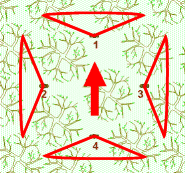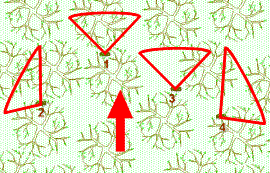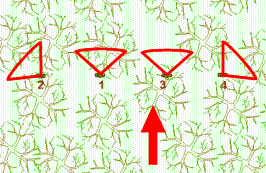Practical Airsoft Recommends:

28 Days Later (VHS/PAL UK Video)

28 Days Later (Soundtrack CD)

28 Days Later (Book)

Fuji Finepix A204 digital camera

Cobra Microtalk 110 PMR446 2-way radio
Practical Fieldcraft, in easy bites (part 1)
Tactical Formations In The Field...

Some background information...
Airsoft games can be fast, furious, and a hell of a lot of fun - but there are a few tips and tricks around, that help to increase your chances of winning the firefights, to increase your enjoyment of the game. One of these little tricks (as it were), is the employment of tactical movement formations. These are set layouts of movement for small units, that take advantage of cover, motion, and fields of fire.
Tactical movement has three general goals:
- To prevent detection;
- To allow effective reaction to opposing team contact; and,
- To protect the unit from opposing team fire, all while moving towards or away from an objective.
A number of techniques have been developed by the military, to meet these goals under specific tactical circumstances, and these can be quite easily adapted to the Airsoft game.
Movement in the field...
Basics
Patrolling, or moving tactically, is an artform in its' own right. Very practiced people can move quickly, and still make very little noise. You probably don't have the experience to do this yet, so practice is what you need. There's an old addage that's very appropriate in this regard for you: "slow and steady wins the race". You need to be careful and cautious, especially at playing sites that you don't know. Spend some time (a few minutes is always well spent) in good cover, just using your ears, breathing gently, listening to the sound of the woods thelselves. This will help you figure out that are natureal souns, and what are man made sounds. There's a big difference. At the same time, get to know the smell of the woodland. People make different smells (not that you'd really notice your own, but it's there. Trust me), so you'll also get to know what smells right, and what smells wrong, in woodland.
Perfection in this takes time, but with practice, you'll get reasonably good enough to tell that the twig that just broke not ten feet from you wasn't a squirrel dropping a nut, but a tip-toeing ten-foot hairy gorrilla carrying a TOP M60, intent on stiching you from heel to head ![]()
Movement in Woodland...
Onto moving. When you do walk in the woods, remember what I said about not skylining, and move slowly, and cover your arcs. Woodland suffers more than its' fair share of dark areas, and the trick here is not to look directly at these areas, but to offset your eyes, similar to peripheral vision, and 'sense' changes in the background. During the daylight hours, yse the EDGES of your feet to initially walk, rolling the soles in slowly to check if there are things underfoot that could make noise, such as small twigs that could break (remember the ten-foot hairy gorrilla?). At nighttime, use the Leopard Walk, where you slowly put the tip of your foot down first, then the outside edges of your feet, when walking. This is damned tiring, but worthwhile.
If you think you have been spotted, STOP! Kneel down in a fluid and quite, but rapid manner, and don't move again. Keep calm, and without moving your head or body, use your eyes and ears to get an idea of where the opposing players might be. By getting down, you'll have lower your target profile, By not moving enything except your eyes, you'll make it difficult for the opposing players to confirm where you are.
Countermeasures and Formations
So, bearing in mind that military engagements normally take place between 100 and 300 metres (often closer), and Airsoft engagements normally take place between point blank and 30 metres, what can be done to convert these military manoeuvres to the Airsoft game?
The easiest adjustment to make to these formations, is to change the spacing (distance) between each team member, thus taking into account the reduced range of Airsoft weapons. Before we get to specifics, however, there are a number of general points you should know, and keep firmly in mind:
- Never take the obvious path.
- Never walk down a road or path - it may be mined, booby-trapped, or ambushed.
- Never come in through a front door if there is a side window.
- Never set up a patrol base in a strategically advantageous location.
- Never blindly pursue a fleeing adversary, especially in close quarters.
- Never leave an objective by the same route you approached it.
- Never poke your head over the top of a wall if you can look around the side.
- Maintain optimal spacing.
Keep as spread-out as possible, without losing contact or concentration of fire. You want to minimize the number of people that can be taken out by a grenade or an ambush. In the woods, spread out to where each person can see the cell leader, but not necessarily the entire formation. On the street, string out so that you canít all be the target of a single burst of gunfire. But always be careful of spreading out too far - you risk being cut apart, unable to manoeuvre, or unable to control and concentrate your fire effectively. - Maintain eye contact.
Every ten or fifteen seconds, look away from your assigned firing arc, and make eye contact with your team leader. This keeps the group cohesive and insures that hand signals get passed on. After all, what good does it do your rear man to keep perfect watch if nobody notices his warning signal? - Remain invisible and silent.
Donít walk along a tree-line - walk parallel to it a few meters inside the woods. Avoid crossing ridgelines, especially bare ones that will leave you silhouetted. Mask your movement with smoke if you must cross open areas and the enemy knows you are there. Never talk unless absolutely necessary - even a whisper into a radio microphone will carry through an empty warehouse or the stillness of the woods. - Avoid patterns.
If you are moving within sight, or potential sight, of the opposing side, donít let them predict your movements. Stagger the movements of members of the team, roll away from cover before getting to your feet, and donít always take the most direct path. - Always think defensively, especially when stopped.
Form an impromptu perimeter whenever you pause. If you stop to discuss plans, check navigation, observe terrain, etc., anyone not directly involved in the proceedings provides all-round defence, watching the flanks and rear. When on the move, people at the rear of the formation need to watch the back, while those on the sides keep their attention on the flanks. If everybodyís eyes are forward, the unit is vulnerable. Donít forget trees, rooftops, culverts, etc.
These few points cover some of the basics of tactical movement. Some specific formations are covered below; you should practice these with your team: They arenít difficult, but take some getting used to, especially in rough terrain, and practice does, after all, make perfect.
Arcs of Fire
 In these formations, you'll see that I refer to team members 'covering their arcs'. The diagram to the right is a typical forward arc. The team member in this diagram is supposed to scan this area, covering it with his rifle. Any targets that show up in the arc should be engaged (i.e. shot at) by the team member.
In these formations, you'll see that I refer to team members 'covering their arcs'. The diagram to the right is a typical forward arc. The team member in this diagram is supposed to scan this area, covering it with his rifle. Any targets that show up in the arc should be engaged (i.e. shot at) by the team member.
Don't forget the basics of team playing: When you do unexpectedly have to shoot at something in your arc - let your team know, by yelling that you're engaging the oposition, and which direction you're firing, for instance, "CONTACT FRONT!"
Spacing
No, this isn't chucking some hapless twit out of an airlock without a space suit!
In tactical formations, 'spacing' refers to the distance between team members. remembering that one sustained burst of fire can take out a small group of players, you need to ensure that the distance between players in your team is sufficient to allow you to move as a unit, but isn't short enough to let the opposition mow you all down with one burst of fire. Generally speaking, half the range of a normal Airsoft gas pistol (around five or so metres) is enough to give everyone time to hit the ground and look for cover, if the team is attacked, and, while at least one member will be hit, the rest should be able to play on.
The basic tactical formations
 Diamond
Diamond
The diamond is ideal for fire teams operating on their own in medium to dense terrain. The four corners of the diamond give good all-around security. Spacing should be at least five metres between each team member, corner to corner, in woodland, and around half again as much to twice as much, in open ground.
However, it's not at all good for fast movement; you should really use this formation when you are expecting to travel through the other side's 'territory', where you may be ambushed from any side: This formation is excellent, in that respect.
 Wedge
Wedge
Use the wedge whenever possible. It works well in most terrain types, and in all but the worst visibility. Keep your personnel as far apart as vegetation and visibility will allow, about five meters apart in forests, maybe twice that in open fields.
When visibility gets too bad to keep a wedge formation together, move to a file, but remember the tactical limitations of the file.
 Single File
Single File
The file formation is used only when visibility prevents other formations, or when you need to move quickly and arenít expecting any enemy contact. A well-spaced file is difficult to ambush, since personnel will be too spread out to fit in a concentrated kill zone, but doesnít allow you to quickly respond to contact. Leaders should stay near the center of the formation, with heavy or indirect-fire weapons nearby. When moving in a file along a country road, stagger your personnel on either side. This makes ambushes even more difficult, and if you have to scramble for cover, not everyone will be bunched up on the same side. Keep spacing to around eight to twelve metres, minimum.
 Line Abreast
Line Abreast
Line abreast formations are used for assaulting enemy positions. Note that the team leader should be in the center, where he can make contact with her personnel and see what is going on. The heavy weapons are nearby, where he can easily coordinate their fire.
When you move in this formation, maintain your spacing so that you move in a wave over the objective area. The tendency to bunch up as you pass over the objective is strong, especially in uneven terrain or dense vegetation. Resist it. Move forward, maintaining your spacing with the operatives on either side of you. Each individual must stay within his or her lane to ensure a clean sweep of the area. Otherwise, you may pass enemy personnel or positions, and this formation provides little protection against attacks from the rear or sides. Each lane should be no less than five metres apart.
Also, be careful to keep moving at an pace even with your team. Itís easy to get too far ahead or to fall behind in this formation, and that will leave gaps and expose your fellow team members flanks to the opposing side.
Donít use this formation to approach your objective, to leave it, or to travel in the field. Use it only in direct assaults: Itís simply too vulnerable for other situations. Once youíre in the line, move quickly and decisively - your speed and the impact of your assault is the only thing that counteracts your lack of security.
 All round defensive positions
All round defensive positions
Security is one of your principal concerns in a tactical environment; you never know what direction a new threat is going to come from. Itís important to keep attention focused outwards, even when dealing with a problem (such as trying to find your location on a map) within the team.
Believe it or not, maintaining such a focus on security requires coordination. The simplest pattern to adopt is the 'All-Round Defence', a formation that, when practiced, becomes easy to adopt, makes communication and coordination simple, and is highly versatile.
The basics of the 'All-Round Defence' are simple: the point man drops prone or to a knee at the twelve-oíclock position. The second team member drops behind and to the right, facing outwards; the third a bit further back and to the left, facing the opposite direction. The remaining operatives alternate sides, except for the last, who takes up a rear-facing direction. If thereís cover for individuals (trees, crates, whatever), use it, but donít deform the circular shape too much or youíll lose the benefit of easy coordination.
The team now has security facing all directions. By forming a sort of oval, instead of a circle, communication and movement within the perimeter is simple, but the team members along the flanks should leave enough space between them to form an unobstructed corridor, so that individuals can move as needed without stepping on each other or exiting the perimeter.
The diagram, by the way, shows how you should arrange yourselves during night games. To remove the need to speak, feet should be touching, so that if a team member spots a member of the other side, all that he needs to to alert other team members in the all-round defensive position, is lightly tap his feet to those of the neighbouring team members. Silent comms is the key, of course!
Obviously, itís easiest to drop into the 'All-Round Defence' from a file formation, facing in the original direction of travel. But with a little practice, your team should be ableto drop to an 'All-Round Defence' facing any direction, from any movement formation, almost instantaneously. You should use it to create a temporary secure position any time youíve got to pause in an Airsoft game.
In conclusion
As you can see, it's all fairly straightforward. Movement in the field doesn't just cover formations, though: There's personal camouflage, noise discipline, the way you actually place your feet, and so on. Over the next few months, I'll be adding to this series, to help you become a more tactical animal, and therefore better at winning those Airsoft games!







